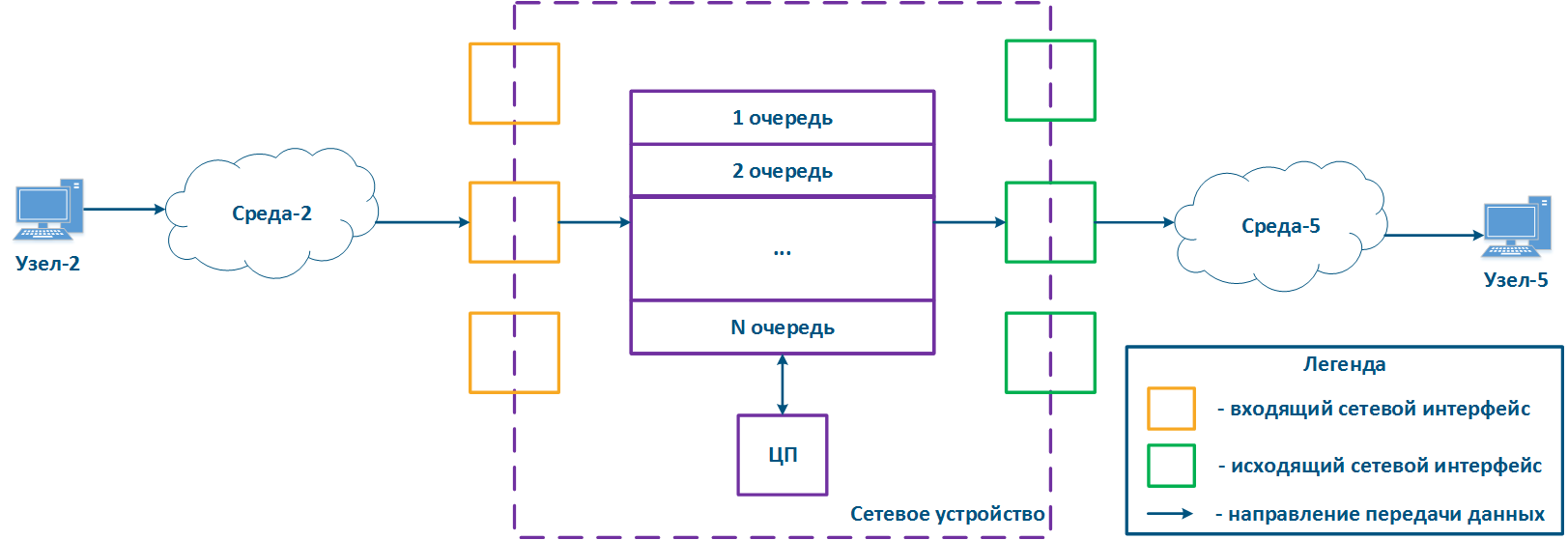...
- Node-2 forms a data packet and transmits it to Environment-2. The data packet is encapsulated in L2-protocol frame used in Environment-2.
- The data frame is distributed in Environment-2. The frame is converted into a modulated signal in accordance with an environment physical properties. Signals used in wired and wireless environments are different, which affects their propagation properties and usage scenarios.
- The signal arrives at the input device interface; after demodulation, the received data frame is checked for integrity: damaged frames are discarded.
- The next stage - routing determines frames further path. If the frame is addressed to a Network device, it is passed for processing to internal services. If the frame is addressed to another node, two scenarios are possible: the frame must be passed further through the output interface, or discarded (if Environment-2 is a common environment, where all signals will be received by all devices connected to the environment. In accordance with the L2 protocols operational principles, if the receiver address in the frame header does not belong to the device, then the device should discard it).
- Если кадр должен быть обработан и передан другому узлу, то кадр поступает в очередь сообщений. Очередь сообщений представляет собой набор буферов, в которые помещаются данные, принятые входящими интерфейсами. Число и объём буферов памяти, в которых хранится очередь сообщений, не стандартизованы и зависит от производителя оборудования. Например, в устройствах семейства InfiLINK 2x2 выделено 32 очереди, 17 из которых доступны пользователю для настройки.
- Кадр данных проходит через очередь сообщений, в которую он был помещен, и поступает в исходящий интерфейс.
- Поскольку очереди сообщений являются связующим звеном между наборами входящих и исходящих интерфейсов, то в устройстве должен быть выделен контроллер, который выполняет заполнение очередей входящими данными и выборку из очередей для передачи исходящим интерфейсам. Как правило, эти функции выполняет центральный процессор (ЦП). Как будет показано далее, заполнение и выборка очередей может выполняться неравномерно и зависеть от классификации потоков данных.
- Исходящий интерфейс формирует модулированный сигнал и передаёт его в Среду-5, к которой подключен Узел-5, являющийся получателем исходного пакета данных.
- Узел-5 принимает сигнал, демодулирует его и обрабатывает полученный кадр данных.
Следует отметить, что в большинстве современных сетевых устройств сетевые интерфейсы являются комбинированными и могут выступать как в роли входящих, так и в роли исходящих.
...
...
- In case the frame should be processed and transferred to another node, it enters the packets queue. A packets queue is a set of buffers that contain data received by incoming interfaces. The number and size of memory buffers for the packets queue storage are not standardized and depend on the equipment manufacturer. For example, the InfiLINK 2x2 devices family has 32 queues, 17 of which are available for configuration by user.
- The data frame passes through the packets queue to which it was placed, and enters the outgoing interface.
- Since packets queues are a link between incoming and outgoing interfaces, a device should have a controller that fills the queues with incoming data and picks data from the queues for transmission to outgoing interfaces. Usually, these functions are performed by the central processing unit (CPU). As will be shown below, the filling and picking data from queues can be performed unevenly and depend on the data streams classification.
- The outgoing interface generates a modulated signal and transmits it to Environment-5 with connected Node-5, which is the receiver of the original data frame.
- Node-5 receives a signal, demodulates it, and processes the received data frame.
Note, in the modern network devices, network interfaces mostly are combined and can operate as both incoming and outgoing.
| Center |
|---|
Figure 1 - A network device traffic passing scheme |
Сетевое устройство может быть промежуточным для нескольких пар узлов, каждая из которых может передавать данные нескольких сервисов (рис. 2а). Рассмотрим схему, в которой Сетевое устройство является промежуточным для трафика пар узлов Узел-1 - Узел-4, Узел-2 - Узел-5 и Узел-3 - Узел-6. Первая пара передаёт данные трёх сервисов, вторая - двух, третья - одного. В общем случае, при отсутствии настроек QoS, данные всех сервисов попадают в общую очередь в порядке поступления их на Сетевое устройство и в этом же порядке будут из очереди переданы на исходящие интерфейсы.
...
